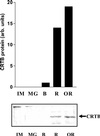Evaluation of transgenic tomato plants expressing an additional phytoene synthase in a fruit-specific manner
- PMID: 11805345
- PMCID: PMC117435
- DOI: 10.1073/pnas.241374598
Evaluation of transgenic tomato plants expressing an additional phytoene synthase in a fruit-specific manner
Abstract
Phytoene synthase from the bacterium Erwinia uredovora (crtB) has been overexpressed in tomato (Lycopersicon esculentum Mill. cv. Ailsa Craig). Fruit-specific expression was achieved by using the tomato polygalacturonase promoter, and the CRTB protein was targeted to the chromoplast by the tomato phytoene synthase-1 transit sequence. Total fruit carotenoids of primary transformants (T(0)) were 2-4-fold higher than the controls, whereas phytoene, lycopene, beta-carotene, and lutein levels were increased 2.4-, 1.8-, and 2.2-fold, respectively. The biosynthetically related isoprenoids, tocopherols plastoquinone and ubiquinone, were unaffected by changes in carotenoid levels. The progeny (T(1) and T(2) generations) inherited both the transgene and phenotype. Determination of enzyme activity and Western blot analysis revealed that the CRTB protein was plastid-located and catalytically active, with 5-10-fold elevations in total phytoene synthase activity. Metabolic control analysis suggests that the presence of an additional phytoene synthase reduces the regulatory effect of this step over the carotenoid pathway. The activities of other enzymes in the pathway (isopentenyl diphosphate isomerase, geranylgeranyl diphosphate synthase, and incorporation of isopentenyl diphosphate into phytoene) were not significantly altered by the presence of the bacterial phytoene synthase.
Figures



References
-
- Grusak M, DellaPenna D. Annu Rev Physiol Plant Mol Biol. 1999;50:133–161. - PubMed
-
- Barton-Duell P. Endocrinologist. 1995;5:347–356.
-
- Giovannucci E. J Natl Cancer Inst. 1999;91:317–331. - PubMed
-
- Seddon J M, Ajani U A, Speruto R D, Hiller R, Blair N, Burton T C, Farber M D, Gragoudas E S, Haller J, Miller D T, et al. J Am J Med Assoc. 1994;272:1413–1420. - PubMed
-
- Lichtenthaler H K. Annu Rev Plant Physiol Plant Mol Biol. 1999;50:47–65. - PubMed
Publication types
MeSH terms
Substances
LinkOut - more resources
Full Text Sources
Other Literature Sources

